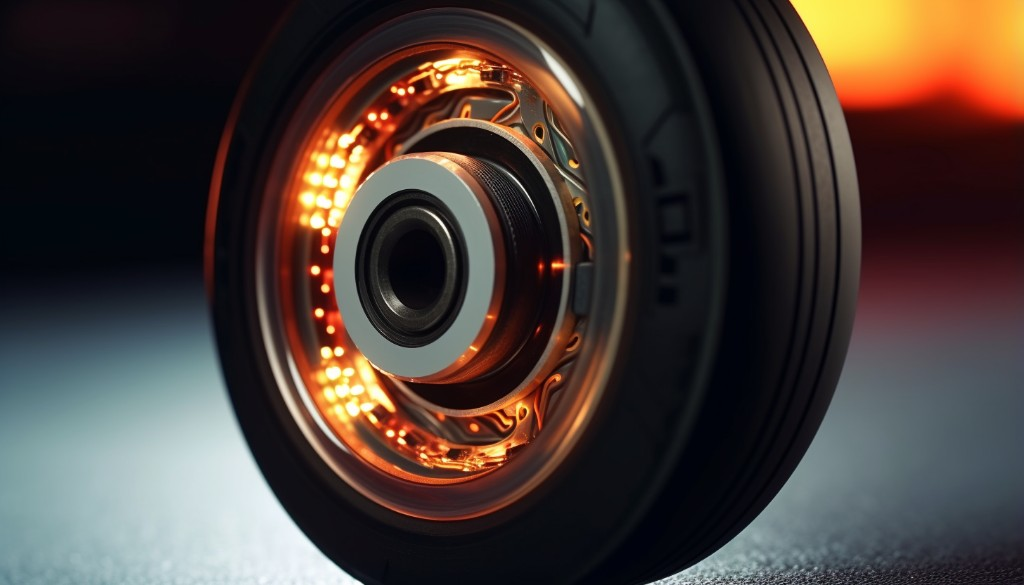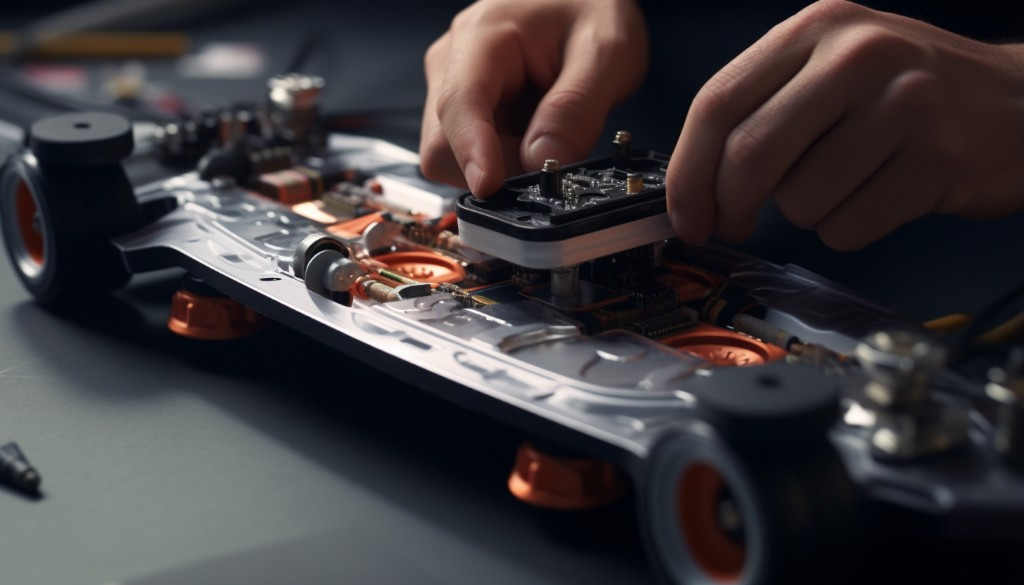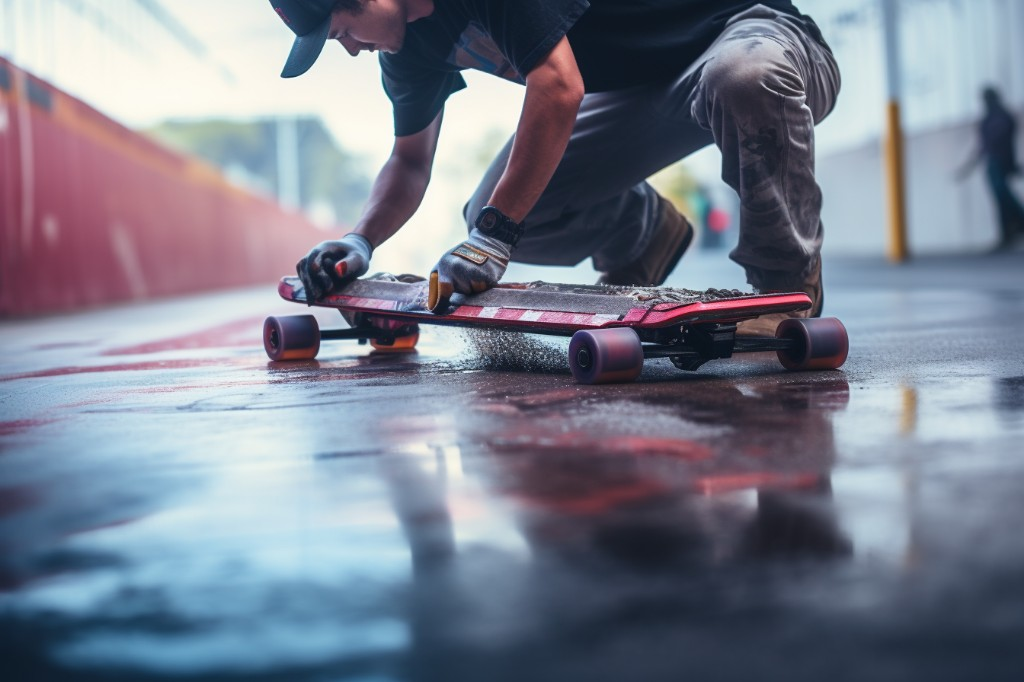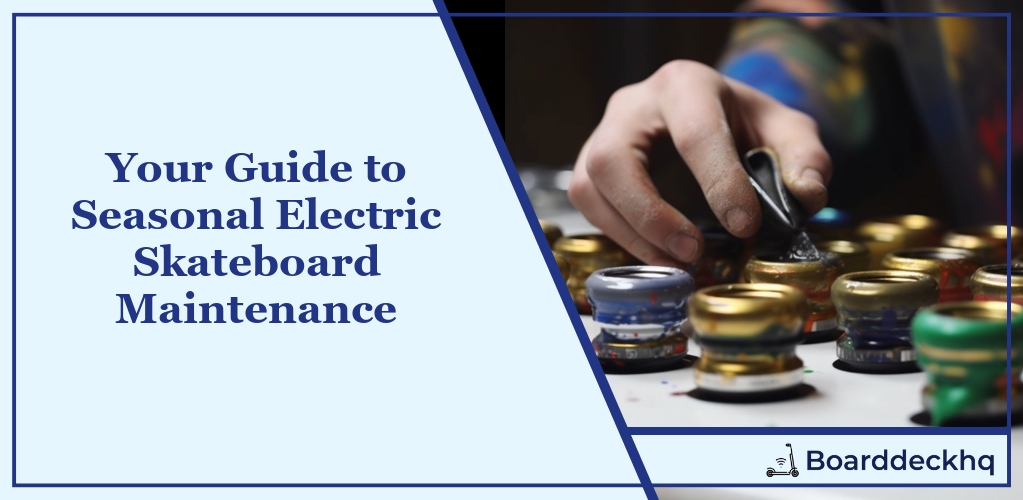Imagine the thrill of gliding on your electric skateboard and feeling the smooth hum of the motor beneath your feet. But to enjoy this exhilarating experience, you must ensure the top-notch condition of your electric longboard, come rain, snow, or shine. This comprehensive guide will teach you everything about essential deck and bearings cleaning, securing connections, battery care, and tire maintenance. Additionally, we will delve into how to adjust wheels, safeguard your skateboard during storage, and understanding the impact of seasonal effects. But that’s not all; our guide also highlights preventive measures against rust and waterproofing, safety checks, and troubleshooting strategies to keep your board in top shape.
What we’ll cover:
- Essential Skateboard Cleaning
- Weather-Aware Skateboarding
- Securing Your Skateboard’s Connections
- Battery Care and Storage
- Tire Maintenance Essentials
- Proper Wheel Adjustments
- Safe Skateboard Storage
- Considering Seasonal Effects
- Preventing Rust and Waterproofing
- Safety Checks for Skateboarding
- Troubleshooting Tips and Repairs
Are you ready to keep your electric skateboard in optimal condition regardless of the season? Let’s jump right in and convince you why regular maintenance and weather considerations play crucial roles in every electric skateboarder’s life!
Essential Cleaning: Deck and Bearings
If you want your electric skateboard to maintain its fantastic performance, one thing you should never overlook is the regular cleaning of the skateboard deck and bearings. Cleaning your equipment is quite straightforward and can be done with simple household items. A clean skateboard will not only look appealing but also perform brilliantly as there won’t be any grime to slow your ride down.

Cleaning the Skateboard Deck
First off, let’s talk about the skateboard deck. Cleaning your electric skateboard deck on a regular basis prevents it from losing its grip tape’s adhesive power and helps reduce the overall wear and tear. A clean deck also gives you a better feel for the board and ensures you have complete control over your moves. Start your skateboard cleaning session with a gentle brush to remove loose dirt. Then, use a mild detergent mixed with warm water to scrub away any stubborn grime.
Maintaining the Skateboard Bearings
Electric skateboard bearings are crucial for a smooth ride, making it important to keep them clean and well-lubricated at all times. To begin with, remove the skateboard bearings from the wheels. Use a special bearing cleaner or an all-purpose cleaner to break down the dirt and grime. Rinse them thoroughly before applying lubricant and reassembling them back onto the wheels.

Weather Considerations: Riding in Rain or Snow
Riding an electric skateboard in different weather conditions can give you a fresh perspective of your surroundings. However, certain conditions such as rain and snow can affect the performance of your electric skateboard.
Impacts of Riding in Rain
The first thing to note is that water, particularly rain, is not good for the electrical components of an electric skateboard.
While riding an electric skateboard in the rain may seem fun, water can seep into the battery housing and other components, causing damage. Additionally, wet surfaces can make it harder to maintain control of the board, increasing the risk of accidents.
Dangers of Riding in Snow
Just as rain, snow also poses significant challenges when riding an electric skateboard. Apart from causing potential damage to the board’s electrical components, snow can make surfaces extremely slippery, resulting in accidents and injuries. Moreover, freezing temperatures can also cause battery efficiency to decrease.

Secure Connections: Checking the Skateboard’s Screws
Arguably one of the most overlooked aspects of electric skateboard maintenance involves the skateboard hardware. The screws that connect the trucks to the board are critical for ensuring both safety and optimum performance.
Importance of Regularly Checking Screws
Skateboarding involves a lot of vibration and impact which can gradually loosen the screws and nuts that hold everything together. Regular screw tightening can prevent mishaps from loose hardware.
Techniques for Screw Tightening
To maintain your electric skateboard effectively, invest in a quality skateboard tool that fits your hardware. Regularly inspect each screw and nut on your board for any signs of wear or loosening. Tighten them as needed but avoid over-tightening as this could strip the threads or damage the deck.
In essence, maintaining your electric skateboard through regularly cleaning, being mindful of weather conditions, and checking hardware connections not only increases its lifespan but also ensures a smoother and safer ride.

Battery Care: Charging and Storage Practices
Electric skateboards thrive on powerful energy sources, the most common of which is the electric battery. This breed of battery, particularly the lithium-ion battery, requires special care and maintenance. One essential requirement for the longevity of your skateboards’ battery life is to properly charge the battery.
The importance of charging your electric skateboard’s battery properly cannot be overstated. Rechargeable batteries are designed to have a specific number of charge cycles. Exceeding this limit by consistently fully draining or overcharging your lithium-ion battery can shorten its lifespan substantially. Hence, it’s crucial to ensure that the battery is charged just right.
A good rule of thumb is to aim for an 80% – 90% charge. Overcharging could lead to overheating, which can damage your lithium-ion battery. On the other hand, allowing your battery to drain completely before recharging can also be harmful. Instead, aim to charge the battery when it is within 20%-30% of its capacity.
Furthermore, it’s essential to store your electric skateboard in a dry and cool place, away from flammable materials. Proper battery storage can significantly increase the lifespan of your electric skateboard’s rechargeable battery. Avoid exposing your skateboard to extreme temperatures, both hot and cold, as these conditions could cause permanent damage to your rechargeable battery.

In addition to the physical environment, consider the state of your battery before storing your electric skateboard for an extended period. Ensure that the battery is charged between 40% – 60% as this is the optimal storage charge level for lithium-ion batteries.
Tire Maintenance: Checking Pressure and Wear
Just as with any vehicle, skateboard tires require regular checks and maintenance, specifically in terms of tire pressure and tire wear. Regularly checking your skateboard tires ensures optimal performance and longevity.
Tire pressure plays a crucial role in the performance of your electric skateboard. It influences the ride comfort, traction, and battery life. A tire that is underinflated will increase rolling resistance, causing your skateboard to work harder and deplete the battery faster. Overinflated tires can compromise grip and make for a less comfortable ride.
To check the wheels for appropriate tire pressure, use a tire pressure gauge. The recommended tire pressure for most electric skateboards ranges between 30-40 PSI (Pounds per Square Inch). However, it’s always best to refer to the manufacturer’s guidelines.
Monitoring tire wear is equally important. Excessive tire wear can lead to decreased grip and stability, which might result in accidents. Regularly check the wheels’ surfaces for any signs of excessive wear such as bald spots or cracks.
Wheel Adjustments: Rotation and Alignment
Wheel rotation is another critical aspect of maintaining your electric skateboard. Electric skateboard wheels tend to wear unevenly due to weight distribution and riding style. By rotating them regularly, you prolong their lifespan and ensure a smoother ride.
To perform wheel rotation, you’ll need to remove the skateboard wheels and swap them around in a cross pattern. In other words, move the front left wheel to the back right position, and vice versa. Doing this will ensure even wear across all four wheels.
On another note, alignment is crucial for smooth riding and effective control. Misaligned wheels can result in pulling or drifting, which can be dangerous at high speeds or in traffic. Regularly check your skateboard wheels for proper alignment and make necessary adjustments for optimal performance.

Skateboard Storage: Safeguarding Your Electric Skateboard
For the longevity and optimal performance of your electric skateboard, secure storage is essential. When you store your skateboard, it’s crucial to consider its requirements and vulnerabilities. The right environment for storage is dry, cool, and clean to safeguard your board against harm.
Firstly, don’t just leave your skateboard anywhere. Make sure to store it in a place where it won’t be knocked over or accidentally damaged. If possible, find a dedicated spot for your board like a shelf, garage, or even build a special rack for it.
Next, avoid exposing your electric skateboard to extreme temperatures. Heat can gradually degrade the battery and other components, while cold can lead to condensation and eventually, rust.
Also, keep your skateboard away from wet environments. Although most electric skateboards are designed to handle some water exposure, continuous wet conditions can lead to corrosion over time.
Seasonal Effects: Cold, Heat, Rain, and Snow
Just like most gadgets, electric skateboards are sensitive to seasonal changes. The performance of your skateboard can fluctuate depending on the weather conditions.
During the cold weather effects, your skateboard’s battery can lose efficiency and the board may not reach its usual top speed. Additionally, cold weather also increases risks of rust if you’re not careful about drying off any snow or slush that your skateboard might encounter.
The hot weather effects are also noteworthy. Elevated temperatures can cause overheating in the electronic components of your skateboard. This is particularly true if your board sits in direct sunlight for an extended period.
Rain effects and snow effects are similarly crucial to consider. These conditions present obvious risks of water damage to your board. While some models are more water-resistant than others, no electric skateboard enjoys being soaked.

Preventive Measures: Rust Prevention and Waterproofing
To offset some of these challenges, preventive maintenance is crucial for your electric skateboard’s upkeep. Simple steps taken in advance can help you avoid costly or irreparable damage down the line.
For rust prevention, make sure to dry off your board after each use, especially if you’ve been riding in a wet environment. Also consider applying a rust-inhibiting spray on the metal parts of your skateboard every so often to provide an added layer of protection.
Waterproofing too can help protect your board from potential damage caused by rain or puddle splashes. Many skateboards come with some waterproofing already, but consider using a waterproofing spray for additional security. However, remember that no electric skateboard is truly waterproof and excessive exposure to water should be avoided.
These methods are by no means foolproof guarantees against damage, but they’re simple ways to extend the lifespan of your electric skateboard and ensure many more seasons of riding enjoyment.
Skateboarding Safety: Checks and Precautions
Before setting out on your electric skateboard, it’s crucial to conduct a series of safety checks. This is the equivalent of a pilot doing a pre-flight inspection, or a driver checking the tyre pressure, brakes, and lights before a long road trip. Performing these checks can prevent accidents and ensure your ride is smooth and safe.
Brake Checks
The most important part of the safety checks is the brake check. Just like when you’re driving a car, having functional brakes on your skateboard is critical for your safety. To do a brake check, you’ll first want to ensure the skateboard is off and not in motion. Then, press down on the brake lever or button (depending on your model) and visually inspect the brake pads to see if they respond. If the pads don’t clamp down or seem loose, it might be time for a repair.
Other Safety Precautions
In addition to the brake check, there are other vital safety checks to consider. For example, checking for any visible damage to the board or its components, ensuring all screws are tightened properly, and verifying that the battery has enough charge for your journey. Getting into the habit of conducting these checks before each ride can significantly enhance your skating safety.

Troubleshooting and Repairs: Keeping Your Board in Top Shape
When it comes to electric skateboard maintenance, understanding basic troubleshooting steps and knowing when to replace parts can keep your board in top shape. It’s like being able to change a flat tire on a car – it’s not something you want to do often, but knowing how can save you a lot of time and hassle.
Electric Skateboard Troubleshooting
The first step in electric skateboard troubleshooting is identifying the problem. Is your board not turning on? Does it feel less stable during rides? Once you’ve identified the issue, you can start investigating possible causes. Some common issues are battery problems, connectivity issues with the remote, or worn-out wheels. A good rule of thumb is to start with the simplest possible cause and work your way up.
Skateboard Parts Replacement
Sometimes, troubleshooting won’t fix the problem, and parts replacement may be necessary. Knowing when to replace parts can save you from more serious damage in the long run. This could be as simple as replacing a worn-out wheel or as complex as replacing the motor or battery system.
Skateboard Repair
If you’re not comfortable replacing parts yourself, it might be time to consider professional skateboard repair. It’s like taking your car to a mechanic – sometimes, an expert’s touch is needed. Repair shops have specialized tools and knowledge to handle more complex issues that might be out of reach for the average rider.
So, whether it’s conducting routine safety checks or troubleshooting a stubborn problem, these steps can help you keep your electric skateboard running smoothly and safely across all seasons.

Closing Thoughts
Maintaining an electric skateboard is a comprehensive task is crucial for optimum performance. It begins with the essential cleaning of the deck and bearings, ensuring they remain dirt-free and well-lubricated. Tire maintenance is also important, and isn’t just about checking for wear but also about ensuring the correct pressure and wheel adjustments for smooth rides. Furthermore, battery care goes beyond just charging; regular checks and proper storage practices can significantly prolong its life.
Seasonal effects like cold, heat, rain, and snow can expose your skateboard to conditions that may impact its performance. In light of this, preventive measures such as rust prevention and waterproofing become essential. Safety should always be a priority; thus, regular checks and precautions need to be undertaken before every ride. Finally, knowing how to troubleshoot and repair common issues will keep your board in top shape and guarantee a smooth skateboarding experience.
In summary, maintaining your electric skateboard involves taking care of its battery, tires and wheels, to name but a few. By doing so, you’ll prolong your electric skateboard’s lifespan and enjoy safer rides.
Frequently Asked Questions
How often should I clean my electric skateboard?
You should clean your electric skateboard after every ride to remove any dust or debris that might have accumulated. This includes cleaning the deck, wheels, and bearings. However, a more thorough cleaning might be necessary every few weeks or months, depending on how often you use your skateboard.
How does cold weather affect my electric skateboard’s performance?
Cold weather can significantly affect your electric skateboard’s battery performance by reducing its capacity. This might result in shorter rides. Additionally, extreme cold can make some components brittle, increasing the risk of breakage. It’s advisable to store your electric skateboard in a warm place during cold weather.
What preventive measures can I take to prolong my electric skateboard’s lifespan?
To prolong your electric skateboard’s lifespan, regularly check and tighten all screws, ensure the battery is properly charged and stored, rotate and align the wheels for even wear, waterproof it to prevent damage from moisture, and store it properly to avoid unnecessary wear and tear.
What should I check before every ride for safety?
Before every ride, ensure that all components of your skateboard are securely fastened. Check the wheels for any signs of wear and ensure they are properly aligned. Verify that your battery is adequately charged and inspect the deck for any cracks or damages. Lastly, always wear protective gear while riding.
How do I troubleshoot common issues with my electric skateboard?
Most common issues with electric skateboards involve battery performance, wheel issues, or connectivity problems. If you notice reduced performance, first check your battery’s charge level and condition. For wheel problems, ensure they are properly aligned and not excessively worn out. If you’re experiencing connectivity issues, ensure your remote control’s battery is charged and it’s within range of your skateboard.
